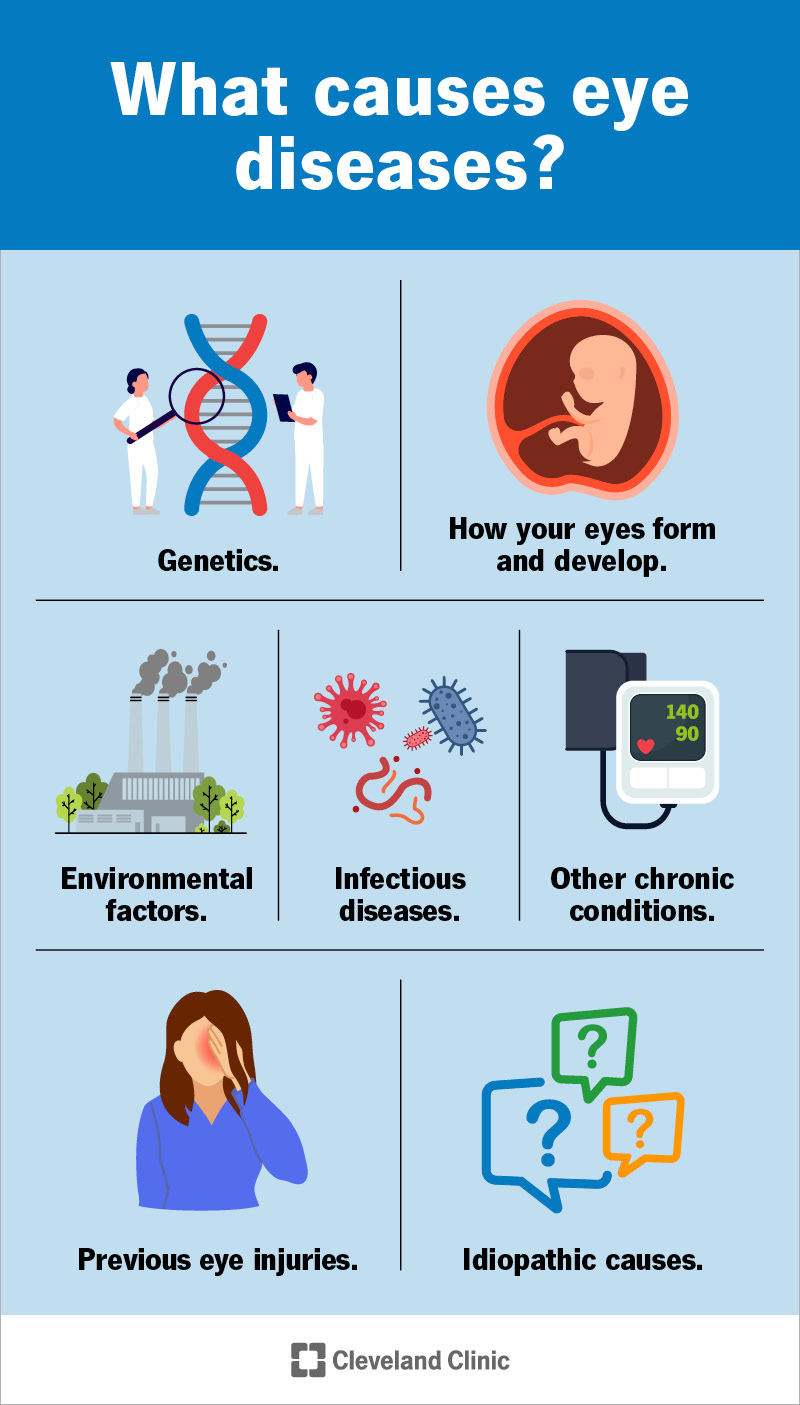Medical science knows of hundreds of eye diseases, and they’re some of the most common conditions in the world. Many are treatable, especially when caught early.
Advertisement
Cleveland Clinic is a non-profit academic medical center. Advertising on our site helps support our mission. We do not endorse non-Cleveland Clinic products or services. Policy

Eye diseases are conditions that affect any part of your eye, and include conditions that affect the structures immediately around your eyes. These conditions can be acute (meaning they develop quickly) or chronic (meaning they develop more slowly and last a long time).
Advertisement
Cleveland Clinic is a non-profit academic medical center. Advertising on our site helps support our mission. We do not endorse non-Cleveland Clinic products or services. Policy
Your eyeball itself is where most eye diseases happen, but it isn’t the only place. Eye diseases also include conditions that can affect your eye muscles, eye socket, eyelids, or the skin and muscles immediately around your eyes.
In general, eye diseases and vision disorders are extremely common. The World Health Organization estimates that over 2.2 billion people have some form of vision impairment or blindness.
One reason that eye diseases are so common is that your eyes don’t exist in isolation from the rest of your body. In fact, the opposite is true. Many conditions that affect your eyes happen because of or in connection with conditions affecting other body systems. That’s why there are hundreds of different conditions that can affect your eyes.
The most common eye diseases worldwide are:
Eye injuries are also a leading cause of vision loss and blindness. Experts track and research them like diseases to find better ways to prevent and treat eye injuries.
Advertisement
Eye cancers and tumors, while rare, do sometimes happen, but often they’re detectable with regular eye exams. Fortunately, many eye tumors are benign (noncancerous). These benign growths may still need removal to prevent them from affecting nearby tissues, but aren’t a greater threat.
There are many types of eye diseases, but there are a few main ways to organize them:
When talking about eye diseases, it’s also important to know the difference between sight and vision.
While many people — experts included — frequently use “vision” and “sight” interchangeably, they aren’t always the same thing. Sight-related diseases are specific to your eyes, while vision-related diseases can involve your brain and optic nerves, too. That’s why some diseases can cause vision loss even though your eyes work just fine.
There are many possible symptoms of eye diseases. Those symptoms usually happen in a few key ways:
Eye diseases can happen for many, many reasons. Some are direct causes while others are contributing or risk factors.
Advertisement
An eye care specialist or other healthcare provider can diagnose eye diseases using a combination of methods. The first and foremost tool for diagnosing these diseases is an eye exam. While most people think of these as just checking how well you see (visual acuity), that’s not always the case.
Eye exams can be routine and happen every one to two years like a regular wellness check. Providers can also do exams in a more specific way when you have signs or symptoms of an eye condition. Certain parts of an eye exam, like pupil dilation and a slit lamp exam, can be especially useful.
Your eye specialist may also recommend more specific eye tests. These include:
Many other tests that aren’t eye-specific can help, too. They include:
Your eye care specialist or other healthcare provider can tell you more about any other tests they recommend, including how those tests work and how they may help you.
Advertisement
Eye disease treatments can vary even more than the conditions they treat. Some treatments can help with many conditions. Others are very specific, meaning they won’t help with anything but the conditions they’re meant to treat.
Refractive errors are some of the most common eye conditions. They’re also usually easier to treat, with corrective lenses like eyeglasses or contact lenses helping to adjust eyesight and improve visual acuity.
Other common treatments for eye conditions include:
Because the treatments can vary so widely and be so specific, your eye care specialist is the best source of information about treatments for your specific needs. They can also tell you about possible side effects, complications and more.
Some eye diseases are completely preventable, and you can at least reduce your risk of developing others. But many eye diseases happen unpredictably, making it impossible to prevent or lower the odds of having them.
Some general steps you can take to help maintain your eye health include:
Advertisement
Children can have many eye conditions that adults have. Some of the most common include:
An important detail about many childhood eye diseases like strabismus and lazy eye is that they’re much easier to treat during early childhood. If you have concerns about whether a child you care for has an eye condition like this, talk to their pediatrician or another healthcare provider. The child’s provider can offer suggestions and guidance on checking for those conditions and what needs to happen next if they think further investigation or treatment is necessary.
Eye diseases are common, but it’s still normal to experience difficult or unpleasant feelings when you learn you have one of these conditions. The type and severity of these conditions vary widely, but most are treatable, and many are curable. Regular eye exams are essential and can help catch these conditions early, when it’s more likely they’ll be easier to treat.
If you have concerns about your vision, talk to an eye care specialist. They can offer guidance, support and reassurance as you work together to manage any conditions you face.
Getting an annual eye exam at Cleveland Clinic can help you catch vision problems early and keep your eyes healthy for years to come.

Last reviewed on 05/02/2024.
Learn more about the Health Library and our editorial process.